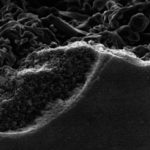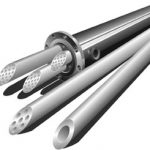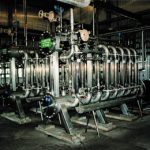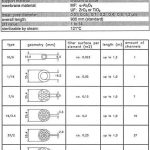Many separation applications where extremely hot or aggressive media are filtered require the use of ceramic membranes. Due to their significantly longer service life and relatively trouble-free operation, ceramic membranes are in many cases even more cost efficient in the long term.
Sven Augustin, Peter Bolduan
Commercially available ceramic membranes are mainly produced in the form of tubular composite membranes based on an open-pored support tube made of a-aluminium oxide. The tube is optimised for maximum water permeability and high mechanical stability. The inner side of the channel is coated with a ceramic membrane and subjected to a sintering process to form a monolithic combination. Depending on the pore size of the membrane, one or more layers with decreasing pore radii are applied (Fig. 1) and sintered.
Membranes and modules
Aluminium oxide membranes are available for microfiltration and ultrafiltration as single-channel or multiple-channel elements with channel diameters between 2 and 16 mm. Their main characteristics are:
• high pressure resistance, backflushable,
• permanent resistance to concentrated, hot acids and caustic solutions,
• high temperature resistance, sterilisable by steam,
• abrasion resistance,
• high flux,
• resistance to oxidation and solvents.
The ceramic membranes are arranged in parallel in pressure casings to form modules (Fig. 2). These pressure casings are manufactured from different types of stainless steel, coated steel or plastic, as required by the application. Special CIP and SIP-compliant casing designs are available for applications in the food and pharmaceutical industries.
Use in hazard conditions
Due to extensive operating experience, even under extreme conditions, ceramic mem-branes based on aluminium oxide are considered a dependable filter medium with an excellent chemical, thermal and mechanical strength that is matched by almost no other material. Ceramic membranes are therefore mainly used in situations where one or more of these special features, not offered by polymer membranes, are required.
Filtration of hot liquids by means of ceramic membranes is of critical importance because high temperatures yield very high specific permeate outputs. No cooling is necessary as would be the case when using polymer materials. Particularly in the waste water and recycling processes (Fig. 3) common in various industries, hot cleaning solvents (T > 80 °C) which are cleaned with very high specific filtrate outputs are generated. These solutions normally have high pH values, so that the membranes must be resistant to caustic solutions even at high temperatures.
In various branches of the chemical industry, Al2O3 membranes can be used to clean aggressive or hot liquids such as waste water (condensates) from distilling processes, which still contain hydrocarbons and are therefore not allowed to be discharged. When filtering organic solvents that contain catalysts, for example, it is possible to use ceramic membranes capable of sustaining high temperatures ( > 100 °C) to recover these catalysts, as they can be very expensive. When plastics are produced or processed, the process and cooling water streams may contain softener residues which have to be separated, because they would otherwise result in deposits or errors on the final pro-ducts. These softeners attack and destroy polymer membranes. Although these water streams can be classified as uncritical as regards their pH value and their temperature, their separa-tion still requires the use of ceramic membranes that are resistant to the softeners.
High operating reliability
Due to the excellent mechanical properties of ceramic membranes, operating modes that cannot be realised with polymer membranes are facilitated for filtration plants. One such example is backflushing from the permeate side in order to blow off deposits. In addi-tion, backflushing is a very effective means of removing clogging from the channels in the membrane tubes. Channel clogging can, for example, result from overconcentration of substances or from cell concentration in biological processes. If the channels in polymer membranes are clogged, it is necessary to open the modules in order to prick the membranes free by means of a wire – something which often results in damage to them.
Separating substances in pharmaceutical and biotechnological applications often means sterilisation. Strong oxidising agents, strong alkaline solutions or hot saturated steam (T > 121 °C) are normally used for sterilisation purposes. Once again, ceramic filters are recommended because polymer materials do not provide permanent stability.
Today, aluminium oxide membranes are increasingly used for applications which could theoretically also be implemented using polymer membranes. In our opinion, this is mainly because of the robustness of ceramic products, which are chosen by the users because of their high operating reliability. In many applications, particularly in production processes, downtimes due to membrane defects or clogging can result in consider-able production losses. Users are increasingly attaching importance to the operating reliability of membrane installations from a financial point of view, and this economic evaluation is often taken into account in the capital-spending decision.
Price advantages
Although ceramic membranes are clearly more expensive than polymer membranes in terms of investment costs per m², price equality is achieved when the total costs per m³ of generated filtrate are compared. If the operating reliability of ceramic membranes and the likelihood of disturbances (channel clogging) is also taken into consideration in the comparison, the ceramic membrane offers a clear price advantage, because membrane installations are only operated for a few weeks per year, notably in campaign operations, and even short downtimes result in high losses. Over the past eight years the price of ceramic membranes has fallen by about 60%. This price reduction partly results from the growing degree of acceptance and the related increased use of ceramic membranes. The multiple-channel design of ceramic membranes that is mainly used today has also contributed to this price development. When a multiple-channel element of the 19-channel type is used with a channel dia-meter of 3.3 mm, a filter area of 0.2 m² per meter is achieved, as opposed to a filter area of only 0.05 m² with a single-channel element having a channel diameter of 16 mm (see inset on this page). The cost of making the casing is also reduced as well if multiple-channel elements are used. The development of ceramic membrane systems will therefore be focused on multiple-channel systems, in order to continuously improve their competitiveness as compared with polymer systems on this extremely price-sensitive market.
atech
Fax: ++49/2043/94 34 34
Further information cpp-246
Unsere Webinar-Empfehlung
Die Websession „Wasserstoff in der Chemie – Anlagen, Komponenten, Dienstleistungen“ (hier als Webcast abrufbar) zeigt technische Lösungen auf, die die Herstellung und Handhabung von Wasserstoff in der chemischen Industrie sicher machen und wirtschaftlich gestalten.
Ob effizienter…
Teilen:














